法律翻译中的“条”、“款”、“项”、“目”
- 格式:docx
- 大小:30.80 KB
- 文档页数:18
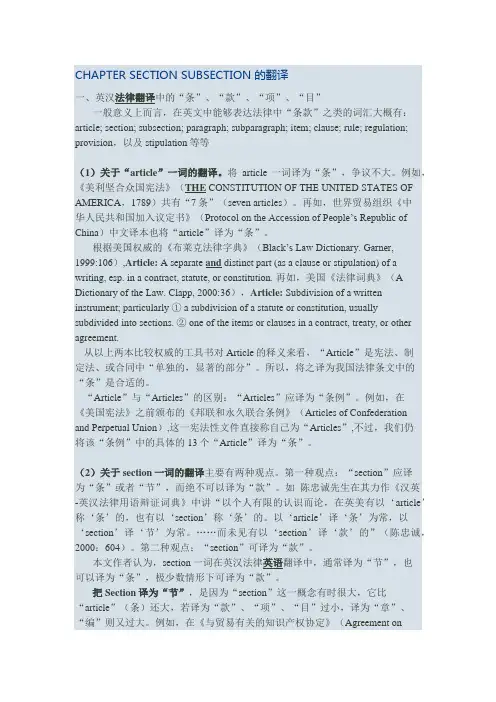
CHAPTER SECTION SUBSECTION 的翻译一、英汉法律翻译中的“条”、“款”、“项”、“目”一般意义上而言,在英文中能够表达法律中“条款”之类的词汇大概有:article; section; subsection; paragraph; subparagraph; item; clause; rule; regulation; provision,以及stipulation等等(1)关于“article”一词的翻译。
将article一词译为“条”,争议不大。
例如,《美利坚合众国宪法》(THE CONSTITUTION OF THE UNITED STATES OF AMERICA,1789)共有“7条”(seven articles)。
再如,世界贸易组织《中华人民共和国加入议定书》(Protocol on the Accession of People’s Republic of China)中文译本也将“article”译为“条”。
根据美国权威的《布莱克法律字典》(Black’s Law Dictionary. Garner, 1999:106),Article: A separate and distinct part (as a clause or stipulation) of a writing, esp. in a contract, statute, or constitution. 再如,美国《法律词典》(A Dictionary of the Law. Clapp, 2000:36),Article: Subdivision of a written instrument; particularly ① a subdivision of a statute or constitution, usually subdivided into sections. ② one of the items or clauses in a contract, treaty, or other agreement.从以上两本比较权威的工具书对Article的释义来看,“Article”是宪法、制定法、或合同中“单独的,显著的部分”。
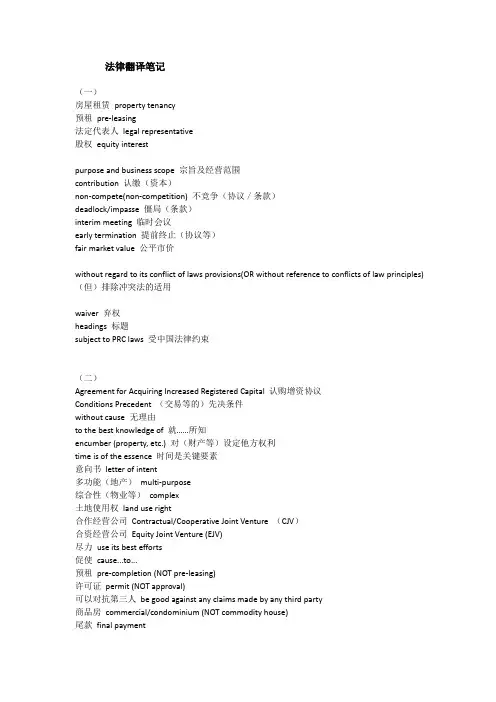
法律翻译笔记(一)房屋租赁property tenancy预租pre-leasing法定代表人legal representative股权equity interestpurpose and business scope 宗旨及经营范围contribution 认缴(资本)non-compete(non-competition) 不竞争(协议/条款)deadlock/impasse 僵局(条款)interim meeting 临时会议early termination 提前终止(协议等)fair market value 公平市价without regard to its conflict of laws provisions(OR without reference to conflicts of law principles)(但)排除冲突法的适用waiver 弃权headings 标题subject to PRC laws 受中国法律约束(二)Agreement for Acquiring Increased Registered Capital 认购增资协议Conditions Precedent (交易等的)先决条件without cause 无理由to the best knowledge of 就……所知encumber (property, etc.) 对(财产等)设定他方权利time is of the essence 时间是关键要素意向书letter of intent多功能(地产)multi-purpose综合性(物业等)complex土地使用权land use right合作经营公司Contractual/Cooperative Joint Venture (CJV)合资经营公司Equity Joint Venture (EJV)尽力use its best efforts促使cause...to...预租pre-completion (NOT pre-leasing)许可证permit (NOT approval)可以对抗第三人be good against any claims made by any third party商品房commercial/condominium (NOT commodity house)尾款final payment业主owner法律翻译Tips# 法律文件中列举项目的最后一项前的"or"或"and"表示充分或必要的逻辑关系,不可略译。

法律翻译中的“条”、“款”、“项”、“目”一、英汉法律翻译中的“条”、“款”、“项”、“目”在英汉法律翻译中,上述词条的翻译不可一概而论。
我们知道,一般意义上而言,在英文中能够表达法律中“条款”之类的词汇大概有:article; section; subsection; paragraph; subparagraph; item; clause; rule; regulation; provision,以及stipulation等等。
(1)关于“article”一词的翻译。
将article一词译为“条”,争议不大。
例如,《美利坚合众国宪法》(THE CONSTITUTION OF THE UNITED STATES OF AMERICA,1789)共有“7条”(seven articles)。
再如,世界贸易组织《中华人民共和国加入议定书》(Protocol on the Accession of People’s Republic of China)中文译本也将“article”译为“条”。
根据美国权威的《布莱克法律字典》(Black’s Law Dictionary. Garner, 1999:106),Article: A separate and distinct part (as a clause or stipulation) of a writing, esp. in a contract, statute, or constitution. (斜体字为作者所加)。
再如,美国《法律词典》(A Dictionary of the Law. Clapp, 2000:36),Article: subdivision of a written instrument; particularly a. a subdivision of a statute or constitution, usually subdivided into sections. b. one of the items or clauses in a contract, treaty, or other agreement.从以上两本比较权威的工具书对Article的释义来看,“Article”是宪法、制定法、或合同中“单独的,显著的部分”。

法律翻译者在翻译立法条文、法学论文、法院判决等法律文件时,常常会碰到诸如“条”、“款”、“项”、“目”等词的翻译,参阅国内一些法律翻译(英汉、汉英)工具书,我们发现,各工具书对上述四个词的翻译或者没有涉及,或者十分混乱。
这些翻译之中,不乏十分正确的翻译,但是有些翻译则值得商榷。
本文作者旨在探讨这一组词的译法,为法律英语词典编纂及法律条文的翻译提供借鉴。
本文从英译汉、汉译英两个方面来说明这一问题。
一、英汉法律翻译中的“条”、“款”、“项”、“目”在英汉法律翻译中,上述词条的翻译不可一概而论。
我们知道,一般意义上而言,在英文中能够表达法律中“条款”之类的词汇大概有:article; section; subsection; paragraph; subparagraph; item; clause; rule; regulation; provision,以及stipulation等等。
(1)关于“article”一词的翻译。
将article一词译为“条”,争议不大。
例如,《美利坚(seven 合众国宪法》(THE CONSTITUTION OF THE UNITED STATES OF AMERICA,1789)共有“7条”articles)。
再如,世界贸易组织《中华人民共和国加入议定书》(Protocol on the Accession of People’s Republic of China)中文译本也将“article”译为“条”。
根据美国权威的《布莱克法律字典》(Black’s Law Dictionary. Garner, 1999:106),Article: A separate and distinct part (as a clause or stipulation) of a writing, esp. in a contract, statute, or constitution. (斜体字为作者所加)。

法律翻译中的forthe purpose(s) of句型泛瑞翻译法律翻译中的forthe purpose(s) of句型翻译含for the purpose(s) of的短语时,首先看它后面跟的是什么。
1. 如果紧跟这个短语的是某个法律条款的指代编号(如章、条、款、节等),首选的翻译是“就(有关)章、条、款、节而言”2. 其次是“为了实施该(条法例)”。
3. 如果原文中的“for the purpose(s) of…”与“章、条、款、节等”无关,而该短语又可以用“for”或“in order to”去取代(这种用法在法律英文中属于少数),则可译成“为了”。
例句:Forthe purposes of this Law, the one-person company with limitedliability means a company with limited liability where there is only oneshareholder who is a natural person or a legal person.本法所称(也就是就本法而言)一人有限责任公司,是指只有一个自然人股东或者一个法人股东的有限责任公司。
For the purposes of subsection (2),”land” doesnot include incorporeal hereditament;就第(2)款而言, “土地”(land) 并不包括无体可继承产;Forthe purposes of subsection (1) permissionshall be in writing.就第(1)款而言﹐许可须为书面形式Forthe purposes of subsection (1) of thissection the attestation of a will by a person to whom or to whose spouse thereis given or made any such disposition as is described in that subsection shallbe disregarded if the will is duly executed without his attestation and withoutthat of any other such person.为第(1)款的施行﹐获得该款所述的处置的任何人或其配偶﹐如为遗嘱作见证﹐而该遗嘱没有其见证或任何这些人的见证亦已属妥为签立﹐则该人所作的见证须不予理会。
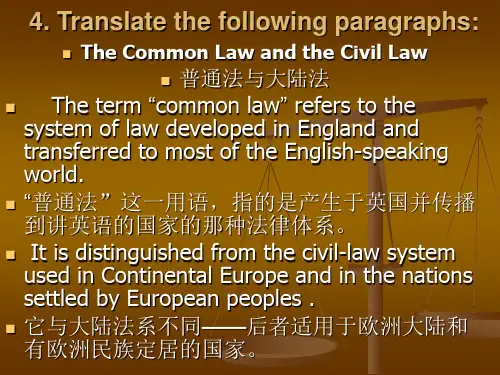
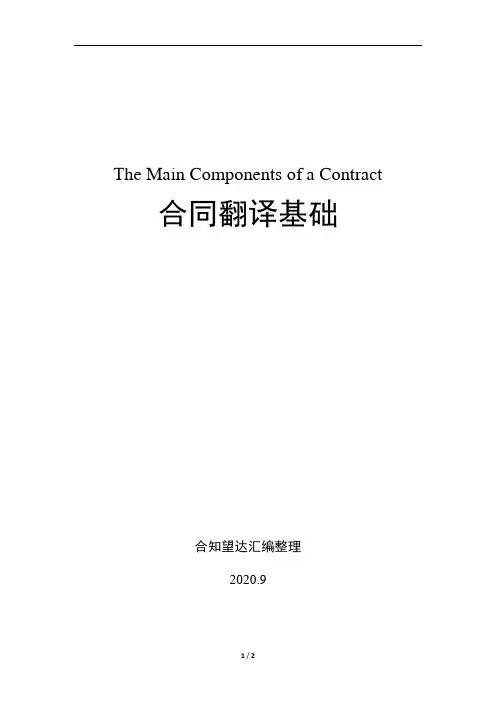
The Main Components of a Contract 合同翻译基础合知望达汇编整理2020.9目录一、合同的结构 (3)二、引言和“鉴于”条款(Preamble & recitals) (5)2.1 合同主体条款Contracting parties (5)2.2 “引言”部分Recitals (6)2.3 有效对价Good and valuable consideration (6)2.4 公平交易Arm's Length terms (7)三、责任与义务(Obligations of the parties)条款 (8)3.1 各方义务(Obligations of the parties)条款 (8)四、价格(Price)条款与支付(Payment terms)条款 (9)4.1 价格条款(Price) (9)4.2支付条件条款(Payment terms) (10)五、合同有效期条款(Terms of contract) (10)5.1 生效Effectiveness (10)5.2 合同期的延长Extension of availability (11)5.3 合同中止/暂停Suspension of contract (11)5.4 合同终止Termination of contract (12)六、损害赔偿条款(Indemnification) (13)七、陈述与保证条款(Representations and warranties) (14)八、保险要求INSURANCE REQUIREMENTS (15)九、不可抗力条款Force Majeure (16)十、合同争议解决(Disputes)条款 (18)十一、司法管辖Jurisdiction (23)十二、证明WITNESS与签署Signatures (24)12.1证明WITNESS (24)12.2 签署Signatures (25)十三、附件附录Schedule, Exhibit, Annex, Appendix, Attachment (25)13.1 附件Schedule (25)13.2 附件Exhibit (26)13.3 附录Appendix (27)13.4 附件/附录Annex (27)13.5 附件attachment (28)一、合同的结构1. 必备条款essential clauses / provisions2. 一般条款/通用条款general provisions3. 特殊条款/专用条款special provisions4. 章.条.款.项.目5. 首部non-operative part (当事人部分parties 陈述部分recital)经营地址,存续情况等6. 正文operative part7. 陈述部分recitals (包括:鉴于条款whereas clause和约因consideration)8. 尾部closing part (证明部分attestation 签字signature 附件appendix)9. 合同主体的名称.姓名和住所name and domicile of the parties10. 适格主体competent parties11. 标的contract object , subject matter12. 数量quantity 质量quality13. 价款或者报酬price or remuneration14. 对价consideration15. 履行时效.地点和方式time limit, place and method ofperformance16. 违约责任default / liability for breach of contract17. 除外规定exception18. 解决争议的方法methods to settle disputes19. 变更modification 终止termination 撤销cancellation 解除rescission20. 主体的变更或权利义务的整体转让novation21. 通知notice22. 违约责任default / breach of contract23. 救济remedies24. 责任的免除exception25. 不可抗力force majeure26. 争议的解决settlement of disputes27. 合同的生效effectiveness / validity28. 合同份数counterpart29. 合同的整体性entirety 合同的可分割性severability 合同的完整性entirety30. 文字效力language31. 法律适用applicable law / governing law32. 保密规定confidentiality33. 副本copies / counterparts34. 性别与单复数gender and singular / plural35. 合同尾部closing clauses / final clause(包括:证明条款attestation 签字部分testimonium / signature 附件部分addendum)二、引言和“鉴于”条款(Preamble & recitals)英语合同,在主体条款之后,往往会有一段“引言”。
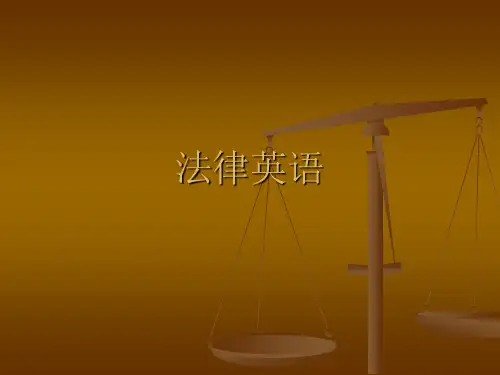
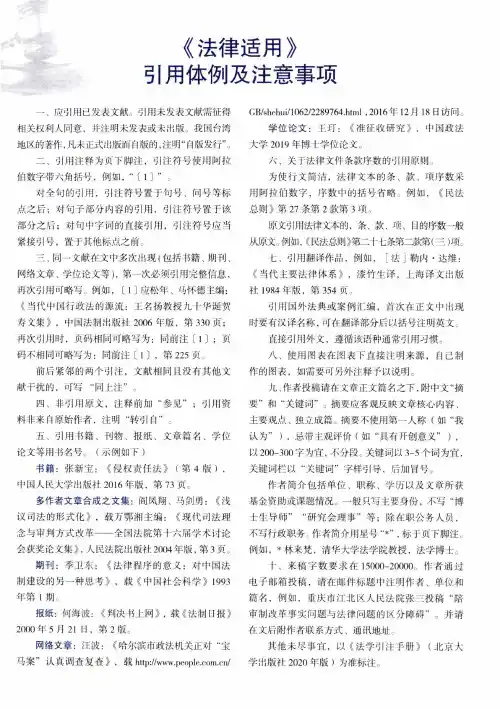
《法律适用》 引用体例及注意事项一、应引用已发表文献。
引用未发表文献需征得相关权利人同意,并注明未发表或未出版=我国台湾 地区的著作,凡未正式出版而自版的,注明“自版发行”。
二、引用注释为页下脚注,引注符号使用阿拉伯数字带六角括号,例如,“〔1〕”。
对全句的引用,引注符号置于句号、问号等标 点之后;对句子部分内容的引用,引注符号置于该 部分之后;对句中字词的直接引用,引注符号应当 紧接引号,置于其他标点之前。
三、同一文献在文中多次出现(包括书籍、期刊、网络文章、学位论文等),第一次必须引用完整信息, 再次引用可略写。
例如,〔1〕应松年、马怀德主编:《当代中国行政法的源流:王名扬教授九十华诞贺 寿文集》,中国法制出版社2006年版,第330页; 再次引用时,页码相同可略写为:同前注〔1〕;页 码不相同可略写为:同前注〔1〕,第225页。
前后紧邻的两个引注,文献相同且没有其他文 献干扰的,可写“同上注”。
四、非引用原文,注释前加“参见”;引用资 料非来自原始作者,注明“转引自”。
五、引用书籍、刊物、报纸、文章篇名、学位 论文等用书名号。
(示例如下)书籍:张新宝:《侵权责任法》(第4版), 中国人民大学出版社2016年版,第73页。
多作者文章合成之文集:阎凤翔、马剑勇:《浅 议司法的形式化》,载万鄂湘主编:《现代司法理 念与审判方式改革——全国法院第十六届学术讨论会获奖论文集》,人民法院出版社2004年版,第3页。
期刊:季卫东:《法律程序的意义:对中国法 制建设的另一种思考》,载《中国社会科学》1993 年第1期。
报纸:何海波:《判决书上网》,载《法制日报》 2000年5月21日,第2版。
网络文章:汪波:《哈尔滨市政法机关正对“宝 马案认真调查复査》,载http ://www .penple .com .cn /GB /shehui /1062/2289764.html ,2016年 12月 18 日访问。

法律翻译中的条款项目(摘抄整理)2008-12-04 11:14:32New Roman'; mso-hansi-font-family: 'Times New Roman'">一、英汉法律翻译中的“条”、“款”、“项”、“目”一般意义上而言,在英文中能够表达法律中“条款”之类的词汇大概有:article; section; subsection; paragraph; subparagraph; item; clause; rule; regulation; provision,以及stipulation等等(1)关于“article”一词的翻译。
将article一词译为“条”,争议不大。
例如,《美利坚合众国宪法》(THE CONSTITUTION OF THE UNITED STATES OF AMERICA,1789)共有“7条”(seven articles)。
再如,世界贸易组织《中华人民共和国加入议定书》(Protocol on the Accession of People’s Republic of China)中文译本也将“article”译为“条”。
根据美国权威的《布莱克法律字典》(Black’s Law Dictionary. Garner, 1999:106),Article: A separate and distinct part (as a clause or stipulation) of a writing, esp. in a contract, statute, or constitution. 再如,美国《法律词典》(A Dictionary of the Law. Clapp, 2000:36),Article: Subdivision of a written instrument; particularly①a subdivision of a statute or constitution, usually subdivided into sections.②one of the items or clauses in a contract, treaty, or other agreement.从以上两本比较权威的工具书对Article的释义来看,“Article”是宪法、制定法、或合同中“单独的,显著的部分”。
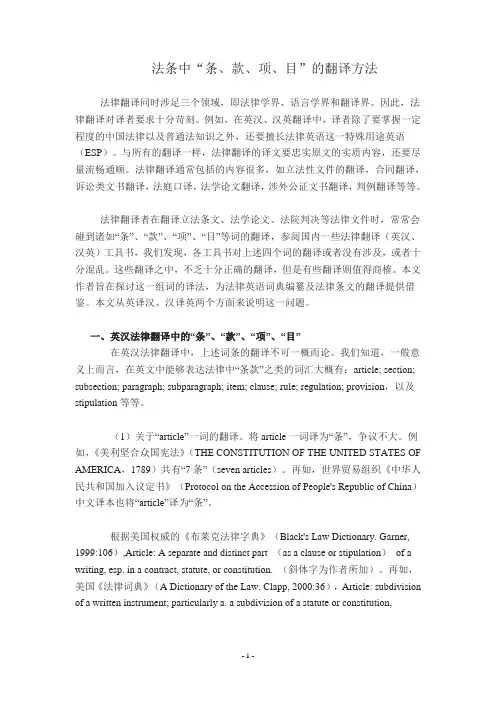
法条中“条、款、项、目”的翻译方法法律翻译同时涉足三个领域,即法律学界、语言学界和翻译界。
因此,法律翻译对译者要求十分苛刻。
例如,在英汉、汉英翻译中,译者除了要掌握一定程度的中国法律以及普通法知识之外,还要擅长法律英语这一特殊用途英语(ESP)。
与所有的翻译一样,法律翻译的译文要忠实原文的实质内容,还要尽量流畅通顺。
法律翻译通常包括的内容很多,如立法性文件的翻译,合同翻译,诉讼类文书翻译,法庭口译,法学论文翻译,涉外公证文书翻译,判例翻译等等。
法律翻译者在翻译立法条文、法学论文、法院判决等法律文件时,常常会碰到诸如“条”、“款”、“项”、“目”等词的翻译,参阅国内一些法律翻译(英汉、汉英)工具书,我们发现,各工具书对上述四个词的翻译或者没有涉及,或者十分混乱。
这些翻译之中,不乏十分正确的翻译,但是有些翻译则值得商榷。
本文作者旨在探讨这一组词的译法,为法律英语词典编纂及法律条文的翻译提供借鉴。
本文从英译汉、汉译英两个方面来说明这一问题。
一、英汉法律翻译中的“条”、“款”、“项”、“目”在英汉法律翻译中,上述词条的翻译不可一概而论。
我们知道,一般意义上而言,在英文中能够表达法律中“条款”之类的词汇大概有:article; section; subsection; paragraph; subparagraph; item; clause; rule; regulation; provision,以及stipulation等等。
(1)关于“article”一词的翻译。
将article一词译为“条”,争议不大。
例如,《美利坚合众国宪法》(THE CONSTITUTION OF THE UNITED STATES OF AMERICA,1789)共有“7条”(seven articles)。
再如,世界贸易组织《中华人民共和国加入议定书》(Protocol on the Accession of People's Republic of China)中文译本也将“article”译为“条”。
英语法律文件中表示条款概念的词语翻译摘要:在法律翻译中,保持原文的正式严谨一向是译者恪守的原则。
但是一篇规范的法律译本不仅应体现在其具体法条的翻译,还应反映在整部法律译本的细节之处,如原语的翻译与目标语法律文件用词习惯的一致性。
当译者遇到article, paragraph之类表示“条款”概念的词语翻译时,常感到难以区分。
本文主要探讨英语法律文本中的相关用词的汉译,以期为今后的法律文件翻译工作提供些许借鉴。
关键词:英语法律文件;条款;翻译一、中文法律文件表示条款概念的词语。
根据《中华人民共和国立法》第五十四条:“法律根据内容需要,可以分为编、章、节、条、款、项、目。
” 比如我国颁布的《中华人民共和国物权法》,共五编十九章二百四十七条。
二、英语法律文件中表示条款概念的词语。
英语法律文件中表示条款概念的词包括:part, chapter, article, section, subsection, paragraph, subparagraph, annex, appendix等。
三、中英文法律文件表示条款概念的单词对比与翻译。
1. “Part,” “Chapter”和“Section.”“编”主要是用于法典中几个相对独立部分的划分;“章”主要用于该法律规定中几个相互联系的部分的划分;“节”是章的下一个层次的划分,但并不是每“章”都必须要有“节”,而是在某些章里,有多个层次的内容需要区分表述。
因此,从中英文表示条款概念大小的用词来看,一般情况下,“part”, “chapter”和“section”分别对应中国法律文本中的“编”、“章”和“节”,(“编”通常也称“部分。
”)但在英文法律文件里,“Section”有时也从属于"article", "section"的其它译法,笔者会在下面的内容专门讨论。
2. “Article.”“Article”一般译为“条”。
AAb initio从开始形容事件由开始时的状态,例如合约从开始便已经无效,称为“The contract was void ab initio”。
Accordaccord在普通英语中的含义是符合,一致,在法律英语中则表示和解或和解协议,指指债务人和一个债权人达成的、以偿还部分债务免除全部债务责任的协议。
如reach an accord达成和解协议,accord and satisfaction和解与清偿等。
Accused被告Accused通常指刑事案件的被告,民事诉讼的被告称为Defendant;而申索案件中的被索偿的一方称为Respondent(答辩人)。
acquireacquire在普通英语中的含义是获得,获取,而且通常指通过后天的努力获得。
在法律英语中通常指对公司的购买,收购,我们通常所说的M&A,即是acquire的名词acquisition和merger的缩写。
如The foreign investor has acquired more than 10 PRC domestic enterprises engaging in related industries within a year. 外国投资者一年内并购中国境内关联行业的企业超过10个。
Acquittal罪名不成立刑事案件经审讯后,被告罪名不成立被释放,称为“The accused is acquitted”。
Acquittal是名词。
Actact在普通英语中的含义是行动,行为,在法律英语中通常理解为作为,与不作为forbear相对应。
如:Notwithstanding anything contained in this Act, the Minister may, on the recommendation of the Commission, direct the Commission to act or forbear from。
英文合同常用词汇和句型1、开场白(合同的当事人背景介绍)2、过渡条款Now therefore,in consideration of the premises and covenants described herein-after,Party A and Party B agree as follows:参考译文:因此,双方基于各自提供之对价订立本合同,并做如下约定:注释和说明:”in consideration of premises and covenants”表示“在当事人提供的对价基础上”而非仅指“考虑到…”.读者应重点理解“premise”这个词。
在一般场合下它是指与房屋相关的基础不动产或处所,但是在英文合同里边它却变成了“前提条件”.3、结尾条款:IN WITNESS WHEREOF,the parties hereto have caused this Agreement to be executed by duly authorized representatives of both parties on the date and year first written above.参考译文:本合同由被正当授权之人,于本协议于上述记载之日期代表双方当事人订立,特此证明.注释和说明:(1)“in witness whereof”的含义类似于中文合同中常见的“口说无凭,立此为证”.(2)“execute”在英文合同中常解为“签署”,而非“执行”。
4、favor,“in favor of somebody"= ”in one’s favor”的意思主要有两种:以某人为受益人、有利于某人5、subject to sth。
1)遵从、遵守:This letter of Credit is subject to the Uniform Customs and Practice for Documentary Credits (1983 Revision), international Chamber of commerce, Publication No。
AAb initio从开场形容由开场时的状态例如合约从开场便已经无效称为“The contract was void ab initio〞。
Accordaccord在普通英语中的含义是符合一致在法律英语中那么表示和解或和解协议指指债务人和一个债权人达成的、以归还局部债务免除全部债务责任的协议。
如rea an accord达成和解协议accord and satisfaction和解与清偿等。
Accused被告Accused通常指刑事案件的被告民事诉讼的被告称为Defendant;而申索案件中的被索偿的一方称为Respondent〔辩人〕。
acquireacquire在普通英语中的含义是获得获取而且通常指通过后天的努力获得。
在法律英语中通常指对的购置收买我们通常所说的MA即是acquire的名词acquisition和merger的缩写。
如The foreign investor has acquired more than 10 PRC domestic enterprises engaging in related industries within a year. 外国者一年内并购中国境内关联行业的企业超过10个。
Acquittal罪名不成立刑事案件经审讯后被告罪名不成立被释放称为“The accused is acquitted〞。
Acquittal是名词。
Actact在普通英语中的含义是行动行为在法律英语中通常理解为作为与不作为forbear相对应。
如:Notwithstanding anything contained in this Act, the Minister may, on the remendation of the mission, direct the mission to act or forbear from。
Actionact在普通英语中的含义是行动在法律英语中那么理解为诉讼相当于suit或lawsuit如initiate an action 提起诉讼win an action在诉讼中获胜defend oneself in an action在诉讼中为自己辩护等。
法律文书翻译一、定义(Definition of legal instrument)Legal instrument is a legal term of art that is used for any formally executed written document.二、分类(Categories)Examples include a certificate, deed, bond, contract, will, legislative act, notarial act, court writ or process, or any law passed by a competent legislative body in municipal (domestic) or international law.三、基本原则(Basic principles)对于法律翻译,译者不宜片面追求形式上的对等,要求译文的词类、语序和句子结构与原文基本保持一致。
法律文件的翻译质量必须用译员对译文的反映程度来衡量。
法律文体的翻译应该遵循奈达提出的“功能对等”翻译原则,即“译文读者对译文的反应等值于原文读者对原文的反应。
1. 公正性(impartiality)是法律专业人员要遵守的最为基本的原则。
2. 准确性( veracity):要求语言使用者对法律概念及所涉及的行为进行严格表达。
3. 合适性(appropriateness):合适性反映翻译的度,主要是对文本原意传达的充分程度。
4. 简洁,精练(conciseness):The simplest, most concise English is the best for legislation:四、用词的基本特点(Features of words )1. 措词精确、避免歧义(precise words)原文:自9月20日起,甲方无权接受任何订单或收据。
法律翻译中的“条”、“款”、“项”、“目”法律翻译者在翻译立法条文、法学论文、法院判决等法律文件时,常常会碰到诸如“条”、“款”、“项”、“目”等词的翻译,参阅国内一些法律翻译(英汉、汉英)工具书,我们发现,各工具书对上述四个词的翻译或者没有涉及,或者十分混乱。
这些翻译之中,不乏十分正确的翻译,但是有些翻译则值得商榷。
本文作者旨在探讨这一组词的译法,为法律英语词典编纂及法律条文的翻译提供借鉴。
本文从英译汉、汉译英两个方面来说明这一问题。
一、英汉法律翻译中的“条”、“款”、“项”、“目”在英汉法律翻译中,上述词条的翻译不可一概而论。
我们知道,一般意义上而言,在英文中能够表达法律中“条款”之类的词汇大概有:article; section; subsection; paragraph; subparagraph; item; clause; rule; regulation; provision,以及stipulation等等。
(1)关于“article”一词的翻译。
将article一词译为“条”,争议不大。
例如,《美利坚合众国宪法》(THE CONSTITUTION OF THE UNITED STATES OF AMERICA,1789)共有“7条”(seven articles)。
再如,世界贸易组织《中华人民共和国加入议定书》(Protocol on the Accession of People’s Republic of China)中文译本也将“article”译为“条”。
根据美国权威的《布莱克法律字典》(Black’s Law Dictionary. Garner, 1999:106),Article: A separate and distinct part (as a clause or stipulation) of a writing, esp. in a contract, statute, or constitution. (斜体字为作者所加)。
再如,美国《法律词典》(A Dictionary of the Law. Clapp, 2000:36),Article: subdivision of a written instrument; particularly a. a subdivision of a statute or constitution, usually subdivided into sections. b. one of the items or clauses in a contract, treaty, or other agreement.从以上两本比较权威的工具书对Article的释义来看,“Article”是宪法、制定法、或合同中“单独的,显著的部分”。
所以,将之译为我国法律条文中的“条”是合适的。
纵然有字典将“Article”译为“节”(李宗锷、潘慧仪,1999:23),或是其它不同翻译,笔者认为,“Article”一词在法律条文翻译中一般应该译为“条”。
读者不能混淆“Article”与“Articles”的意义、用法。
“Articles”应译为“条例”。
例如,在《美国宪法》之前颁布的《邦联和永久联合条例》(Articles of Confederation and Perpetual Union),这一宪法性文件直接称自己为“Articles”,不过,这不妨碍我们仍将该“条例”中的具体的13个“Article”译为“条”。
(2)关于section一词的翻译,分歧比较大,主要有两种声音。
第一种观点:“section”应译为“条”或者“节”,而绝不可以译为“款”。
如陈忠诚先生在其力作《汉英-英汉法律用语辩证词典》中讲“以个人有限的认识而论,在英美有以‘article’称‘条’的,也有以‘section’称‘条’的。
以‘article’译‘条’为常,以‘section’译‘节’为常。
……而未见有以‘section’译‘款’的”(陈忠诚,2000:604)。
第二种观点:“section”可译为“款”(薛波,2003:1234),此外,注释所言,余叔通主编《新汉英法学词典》中也认为“款”可以译为“section”。
依笔者看,section一词在英汉法律英语翻译中,通常译为“节”,也可以译为“条”,极少数情形下可译为“款”。
把Section译为“节”,是因为“section”这一概念有时很大,它比“article”(条)还大,若译为“款”、“项”、“目”过小,译为“章”、“编”则又过大。
例如,在《与贸易有关的知识产权协定》(Agreement on Trade-Related Aspects of Intellectual Property Rights,简称Trips协议)中,第二部分《关于知识产权效力、范围和使用的标准》(Standards Concerning the Availability,Scope and Use of Intellectual Property Rights)包括8个section,第三部分《知识产权的实施》(Enforcement of Intellectual Property Rights)包括5个section,每个section又包括若干条article。
此时,译为“节”最好。
事实也如此,例如,第二部分中的“SECTION 1: COPYRIGHT AND RELATED RIGHTS”,中文翻译便将之译为了“第一节:版权和相关权利”。
关于这点,读者可参看北大法律信息网,Trips协议相关中、英文内容。
把section译为“条”,这点很好理解。
当section译为“条”时,subsection则译为“款”。
根据A Dictionary of the Law (Clapp, 2000: 389),Section: a subdivision of a statute or document, represented by the symbol§(or§§for “section”). Most statutes and codes are divided into sections.另外,subsection: A part within a section of an act .Each section in a Statute may befurther divided into subsections… A subsection is denoted as a number with brackets. For example, s.78(1)of the Trade Practices Act would read as section 78 subsection 1.(陈忠诚,2000:605),上述解释说明,section可译为“条,”subsection则可译为“款”。
此外,经笔者检索,加拿大法《北美法案》(British North America Act)、《英国货物买卖法》(SALE OF GOODS ACT 1979)等法律条文中均使用Section来表示“条”,subsection表示“款”。
由于人们常将上述《美国宪法》中第1-4条(article)中数目不等的“section”译为“款”,而很少有人将这里的“section”译为“节”,所以,将“section”译为“款”,已经是人们约定俗成的一种情形。
翻开今天的“外国法制史”类教材,我们可以发现这一事实(何勤华,1998:55;由嵘,2000:355)。
总之,英汉法律翻译中的“section”是个相对的词,翻译的时候,译者需发挥主观能动性,选择合适的对应词为好。
但是,同一篇法律条文中,必须遵循“译名同一律”,不可毫无规矩。
(3)关于paragraph, subparagraph 的翻译。
笔者认为,应将paragraph, subparagraph分别译为“条”、“款”。
以往的翻译中,人们也大都将paragraph,译为了“条”。
这点问题不大。
Trips 协议中,第3条、第64条中有这样的例子。
1. Any Member availing itself of the possibilities provided in Article 6 of the Berne Convention (1971) or paragraph 1 (b) of Article 16 of the Rome Convention shall make a notification as foreseen in those provisions to the Council for TRIPS.任何利用《伯尔尼公约》第6条或《罗马公约》第16条第1款(b)项规定的可能性的成员,均应按这些条款中所预想的那样,向TRIPS 理事会做出通知。
2. Subparagraph 1 (b) and 1 (c) ofArticle XXIII of GATT 1994 shall not apply to the settlement of disputes under this Agreement for a period of five years from the date of entry into force of the WTO Agreement.自《WTO协定》生效之日起5年内,GATT 1994第23条第1款(b)项和(c)项不得适用于本协定项下的争端解决。
(4)其他词的翻译。
“Item”一词译做“目”非常合适。
因为“Item”常常是subparagraph(项)下的一个部分。
让我们来参考Black’s Law Dictionary (Garner 1999: 837)中对此的解释,Item: In drafting, a subpart of a text that is next smaller than a subparagraph. In federal drafting, for example, “(4)”is the item in following citation: Rule 19 (a) (1) (B) (4). Also termed clause in this sense.这个解释最后提到了“clause”这个词。
关于clause一词的翻译,笔者认为,除了可以将其译为“目”之外,更多的情形下应将其译为泛指意义上的“条款”。
例如,《新英汉词典》(1985:208)中对“clause”这个词的解释就是“条款”、“款项”。